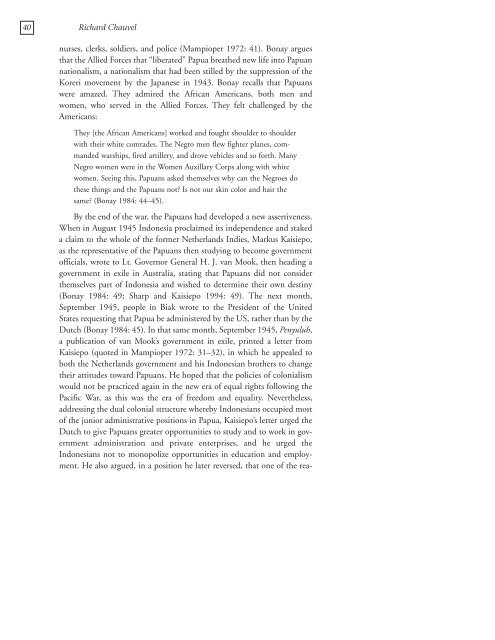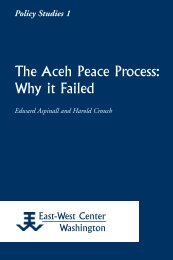Constructing Papuan Nationalism: History, Ethnicity ... - ScholarSpace
Constructing Papuan Nationalism: History, Ethnicity ... - ScholarSpace
Constructing Papuan Nationalism: History, Ethnicity ... - ScholarSpace
- No tags were found...
Create successful ePaper yourself
Turn your PDF publications into a flip-book with our unique Google optimized e-Paper software.
40 Richard Chauvelnurses, clerks, soldiers, and police (Mampioper 1972: 41). Bonay arguesthat the Allied Forces that “liberated” Papua breathed new life into <strong>Papuan</strong>nationalism, a nationalism that had been stilled by the suppression of theKoreri movement by the Japanese in 1943. Bonay recalls that <strong>Papuan</strong>swere amazed. They admired the African Americans, both men andwomen, who served in the Allied Forces. They felt challenged by theAmericans:They [the African Americans] worked and fought shoulder to shoulderwith their white comrades. The Negro men flew fighter planes, commandedwarships, fired artillery, and drove vehicles and so forth. ManyNegro women were in the Women Auxillary Corps along with whitewomen. Seeing this, <strong>Papuan</strong>s asked themselves why can the Negroes dothese things and the <strong>Papuan</strong>s not? Is not our skin color and hair thesame? (Bonay 1984: 44–45).By the end of the war, the <strong>Papuan</strong>s had developed a new assertiveness.When in August 1945 Indonesia proclaimed its independence and stakeda claim to the whole of the former Netherlands Indies, Markus Kaisiepo,as the representative of the <strong>Papuan</strong>s then studying to become governmentofficials, wrote to Lt. Governor General H. J. van Mook, then heading agovernment in exile in Australia, stating that <strong>Papuan</strong>s did not considerthemselves part of Indonesia and wished to determine their own destiny(Bonay 1984: 49; Sharp and Kaisiepo 1994: 49). The next month,September 1945, people in Biak wrote to the President of the UnitedStates requesting that Papua be administered by the US, rather than by theDutch (Bonay 1984: 45). In that same month, September 1945, Penyuluh,a publication of van Mook’s government in exile, printed a letter fromKaisiepo (quoted in Mampioper 1972: 31–32), in which he appealed toboth the Netherlands government and his Indonesian brothers to changetheir attitudes toward <strong>Papuan</strong>s. He hoped that the policies of colonialismwould not be practiced again in the new era of equal rights following thePacific War, as this was the era of freedom and equality. Nevertheless,addressing the dual colonial structure whereby Indonesians occupied mostof the junior administrative positions in Papua, Kaisiepo’s letter urged theDutch to give <strong>Papuan</strong>s greater opportunities to study and to work in governmentadministration and private enterprises, and he urged theIndonesians not to monopolize opportunities in education and employment.He also argued, in a position he later reversed, that one of the rea-
















